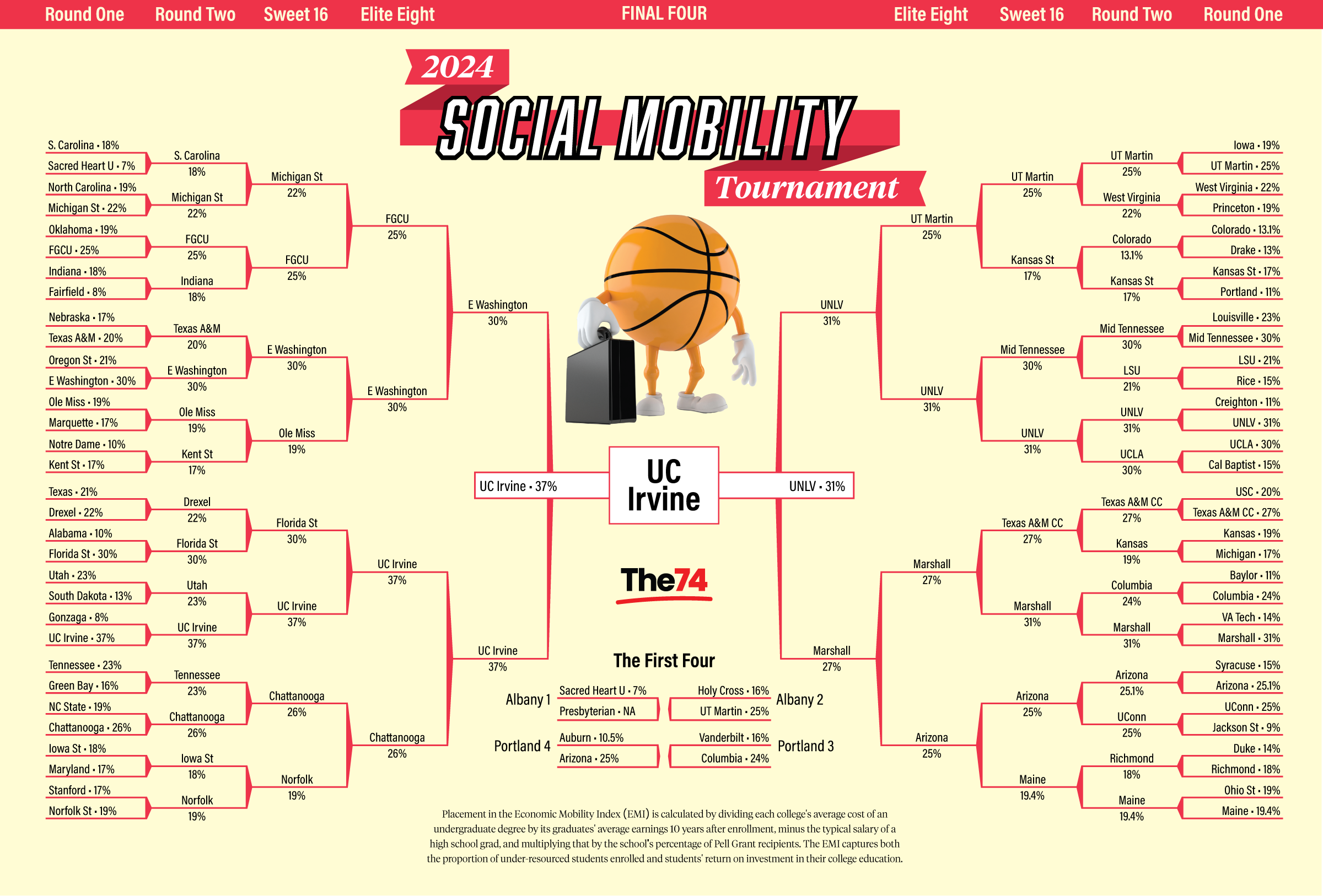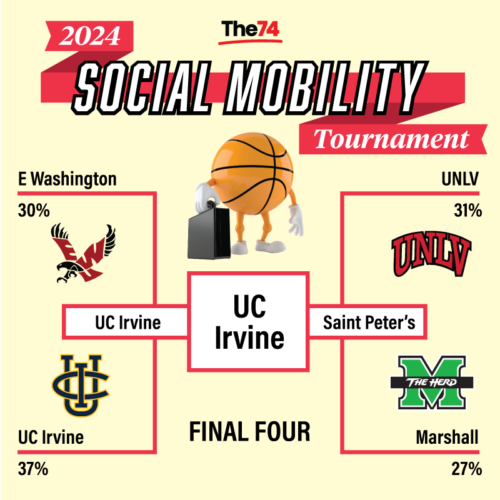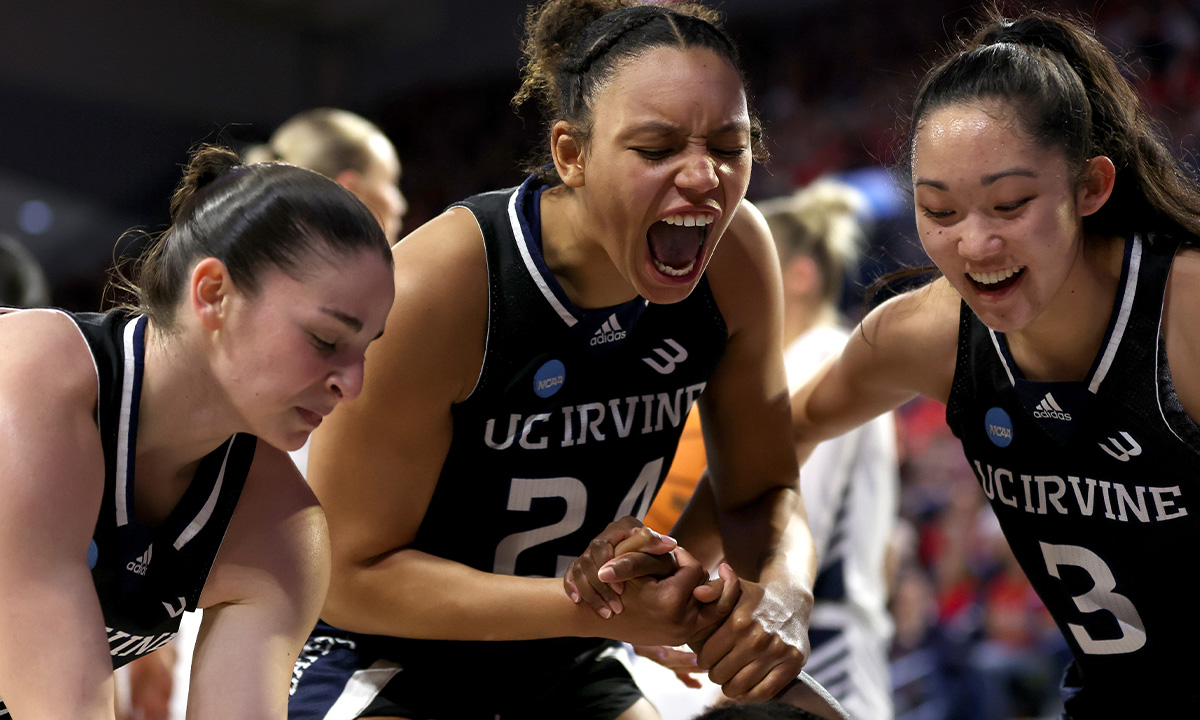If March Madness Women’s Tourney Colleges Won for Boosting Students’ Social Mobility, UC-Irvine Would Be Champion
Our bracket ranks NCAA schools by percentage of low-income students, return on investment & how well grads move up the economic ladder
By Jorge Klor de Alva | March 28, 2024It’s a challenge to capture the excitement surrounding this year’s NCAA Division 1 women’s basketball tournament. In the first round, Iowa’s future WNBA star, Caitlin Clark, scored 27 points and had 10 assists to lead the Hawkeyes to victory over the Crusaders of Holy Cross. Not to be outdone, Kiki Iriafen led the Stanford Cardinals to an overtime victory over the Iowa State Cyclones with an incredible 41 points! No matter which team you’re rooting for, this is exciting stuff. And what should be no less thrilling is knowing how well some of the tournament’s schools succeed in putting their students on the path to economic security.
For the second year in a row, we have taken colleges participating in the women’s tournament and plotted them on an alternative bracket based on how well, or how poorly, they help make the American Dream of upward mobility a reality for their students.
Our parallel bracket makes use of an Economic Mobility Index (EMI) created by Michael Itzkowitz, former director of the U.S. Department of Education’s College Scorecard. This index uses information from the department and the Census Bureau to calculate the out-of-pocket costs required to obtain a four-year degree and the return on investment for lower-income students at each school. Then, an earnings premium is determined, representing the extra income these students make 10 years after graduation in comparison with someone with only a high school diploma. It follows that the lower the cost to obtain a degree and the higher the earnings premium, the less time a graduate will need to pay down the total net cost of a degree.
Because access is a major concern for parents and students, the EMI also considers the proportion of low- to moderate-income students enrolled, in order to measure how great an impact each school is making on the future of underresourced students. To make this assessment, the percentage of Pell Grant recipients (a proxy for low family income) at each college is multiplied by its percentile rank on return on investment that each school offers its students versus other colleges.
The result is the college’s placement within the EMI and, therefore, its location on our Social Mobility Tournament bracket. The EMI rewards schools for both their proportion of lower- and moderate-income students and the additional return on investment it provides them.

This year’s Sweet Sixteen in our Social Mobility Tournament bracket are all public universities, which educate the majority of low- and middle-income students. With the exception of the Kansas State Wildcats and the Rebels of Ole Miss — both of which lost in the second round — the rest of our Sweet Sixteen never made it past the first round of the NCAA tournament.
However, what they lacked on the court was more than made up by their strength as social mobility powerhouses. Together, the 16 colleges educate nearly 293,000 undergraduates, an average 35.6% of whom are Pell Grant recipients who manage to pay back the cost of their education in approximately 2.5 years. This is made possible by an earnings premium that averages some $19,400 over the income of those with only a high school diploma.
These numbers make possible EMI rankings between 51 and 536 (out of 1,320) and percentages from 16.9% to 37.3% (on a range of 0 to 66.7%). In short, our Sweet Sixteen rank higher than almost 60% of all other colleges in the EMI dataset, hundreds of which — whether public or nonprofit private schools — require 10 or more years to pay down the cost of their degree. And many offer only a small earnings premium beyond that of a high school graduate.
The Elite Eight in our bracket represents a significantly higher level of accomplishment compared with those that lost in the round of 16. First, their EMI rankings are much higher (ranging between 51 and 216). These eight colleges serve nearly 141,400 students, nearly 36% of whom are Pell Grant-eligible. With an average earnings premium of $18,000, their graduates pay back the cost of their education in just over two years.
Still, our Final Four are in a class of their own. UNLV’s Lady Rebels won 15 straight games on their way to the Mountain West championships. Though they lost in Round One, they rank 108th on the index, with an EMI of 31.1%. With over 37% receiving Pell Grants, UNLV students pay off their schooling in less than two years and enjoy an earnings premium of nearly $18,000. Meanwhile, the Eastern Washington Eagles, experiencing their best season ever, beat Northern Arizona to capture the Big Sky Conference championship. Unfortunately, they were no match for the Oregon Beavers in the first round of the NCAA tournament, but they rank 117th in the EMI at 30.4%.

In the meantime, Marshall University’s women ended their basketball season 26-7 and captured the Sun Belt Women’s Basketball championship, earning their first bid to the NCAA tournament since 1997. Though they suffered a lopsided loss to the Virginia Tech Hokies in Round One, they have every reason to be proud of their school. Attending a school ranking 110th in the index, with an EMI score of 30.8%, the Thundering Herd pay only $24,100 for their degree while experiencing on average an earnings premium of $10,125. This makes it possible to pay off their degree in only 2.4 years. All this with a student population that is nearly 40% lower-income.

Which leads us to the 2024 Social Mobility Tournament bracket champion: the University of California-Irvine Anteaters. They earned a spot in the NCAA tournament by defeating UC-Davis in the Big West Conference tourney. But they earned our bracket’s championship because their school does something far better for its students. With an average degree cost of $36,700 and an earnings premium of over $36,900, Anteaters can pay down the total net cost of their degree in one year. This helps put Irvine’s nearly 12,000 Pell students higher up on the escalator leading to family-sustaining earnings. With these numbers, the university has earned an exemplary EMI ranking of 51 in the index and a 37.3% EMI.
We look forward to this year’s NCAA Elite Eight and Final Four games, but most of all, we look forward to seeing colleges receive the attention and support they merit when they do as well for their students as our Sweet Sixteen manage to do for theirs.
Get stories like these delivered straight to your inbox. Sign up for The 74 Newsletter
